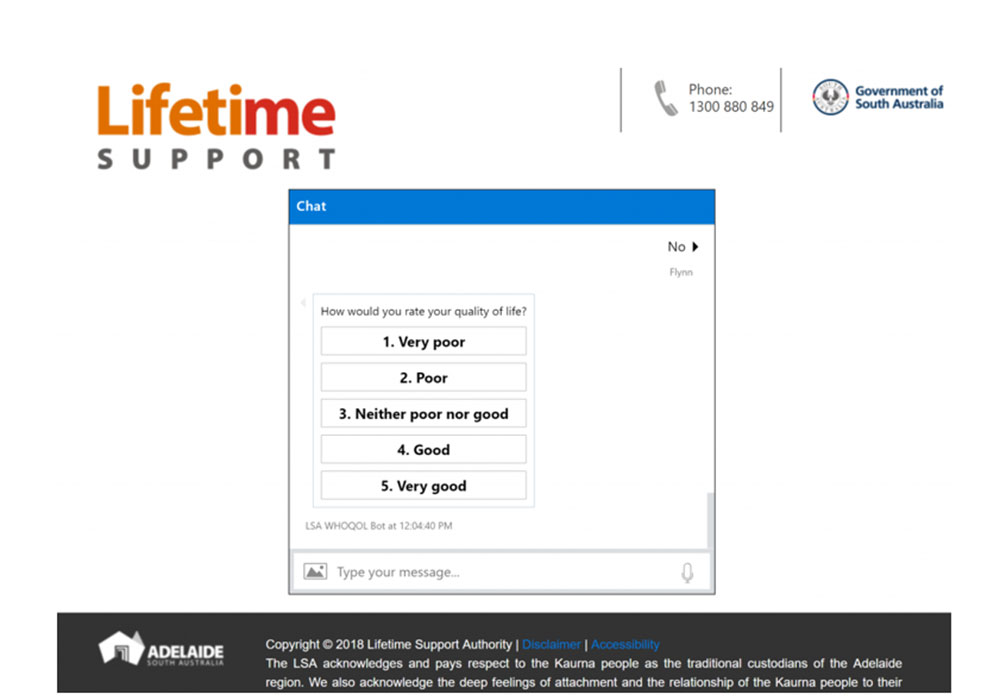The Lifetime Support Authority is a statutory authority that administers the Lifetime Support Scheme; providing treatment, care, and support to people who have sustained severe injuries in a motor vehicle accident.
South Australia’s Lifetime Support Authority has a solid business case for investing in an intelligent bot. As a service provider in the government sector, the priority is to focus on the participants of the scheme. Technology enabling automation of repetitive and time-consuming administrative tasks to free up time for spending on face-to-face care is high on LSA’s agenda.
Bots and chatbots have been around for a while now. However, advances in cloud technology like Azure Bot Services mean bots have become more intelligent and versatile. More importantly, cloud technology provides greater availability and scalability for low development effort and maintenance costs.
Objectively tracking a participant’s emotional and physical wellbeing is an extremely important aspect of caring for scheme participants. LSA uses the World Health Organisation’s Quality of Life (WHOQoL) survey to regularly collect data on a participant’s physical and mental wellbeing. Taking up to 2 hours and completed face to face, the quarterly assessment process is comprehensive and time-consuming. Certainly, it’s an important task, but it’s also time-consuming and leaves little time to discuss the next steps in the participant’s journey. Once the care planner has the information collected in paper form, they manually enter the information into an Excel spreadsheet. The manual entry and analysis add further complication and additional time to the process.
As the number of participants in the scheme increases, this repetitive administration task will become more onerous and take further time delivering a quality service.
As part of delivering its 2020 Strategy objectives, LSA engaged Satalyst, part of Canon Business Services Australia, as a technology partner to provide a business modernisation solution. Satalyst helped LSA to identify technologies and solutions to automate tasks and information flow through systems integration and streamlining processes. Automation of administration activities frees up time. As service providers, this is crucial for improving scheme participant experiences by enabling service planners to focus on the participants’ support needs.
The resulting automation solution is an intelligent bot application built on Microsoft’s Azure Bot Framework. The bot is initiated by an automated process flow from LSA’s Salesforce core management system. An email invitation is sent to the participant asking them to activate the bot. This happens a few weeks before a scheduled visit from a service planner and enables the participant to complete the questionnaire in their own time. The participant then completes the survey using the bot and directly entering the information or by voice control. Furthermore, participants can also provide additional information when directed by the bot to help elaborate on their answers. This can be done using free text form or via speech to text functionality.
The chatbot allows full audio/voice interaction on supported platforms. Additionally, the bot will read the questions to the participant and receive the answers as they are spoken. This option makes the solution more accessible to those with disabilities impacting how they interact with computers and devices.
On completion of the survey, the bot compiles and analyses the results and uploads them directly into Salesforce. An automated process flow sends a notification to the service planner letting them know there are results ready for review.

Using advanced cloud technology, the LSA WHOQoL Bot is built on the Microsoft Bot Framework and uses the Azure Bot Service. The Azure Bot Service enabled the acceleration of development by providing an integrated environment that’s purpose-built for bot development. All data transmitted contains no identifying information.
As part of its 2020 Strategy, Lifetime Support Authority (LSA) is actively looking for ways to leverage enhancements in technology to:
• Improved engagement by providing a better customer experience
• Cost savings by saving on employee costs and reducing error
• Data for insight and triggering next step process flows
• empower participants and increase their independence and quality of life;
• improve service delivery and interactions with participants and service providers;
• support and enable staff; and
• simplify and streamline processes.
LSA’s aim is to be nimble, responsive and available through technology.
The resulting solution has solved a real business problem for LSA. The bot allows the service planners to be more productive and efficient in their tasks. This tangible improvement in staff productivity flows through to an improved experience for all by freeing time for more valuable face to face time with participants. Furthermore, the technology doesn’t disadvantage anyone. When a participant is unable or doesn’t want to complete the survey by themselves, the service planner can use the bot and complete the survey with them. Hence, the solution still enables better engagement and the benefits of the automation and time-saving processing of the solution.